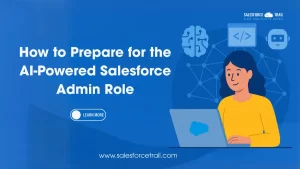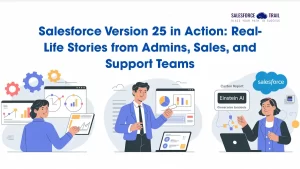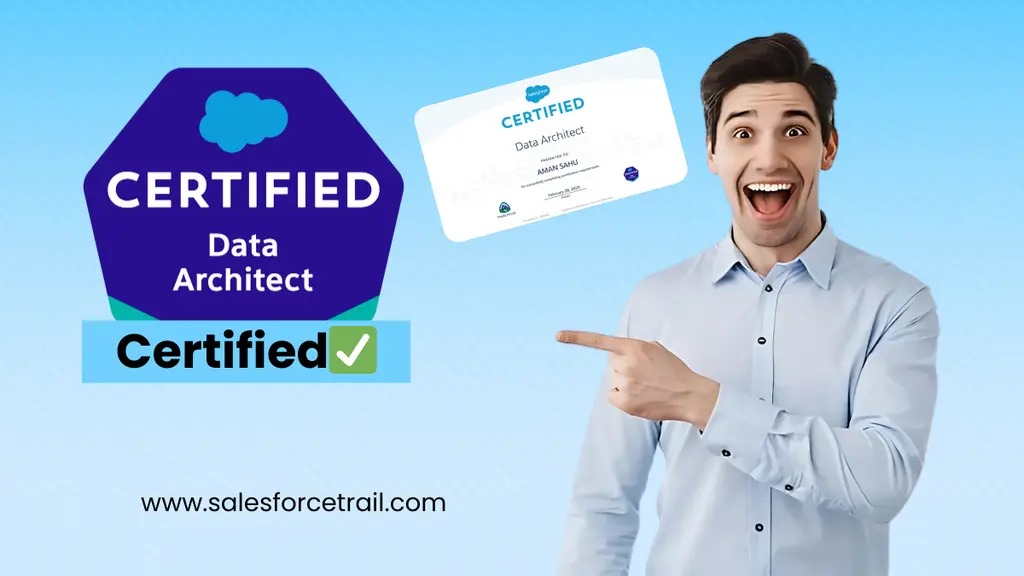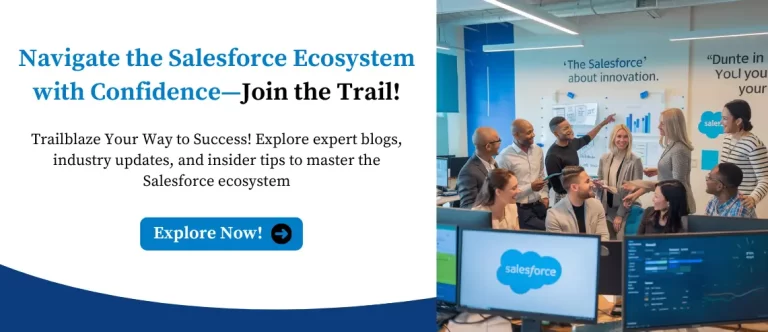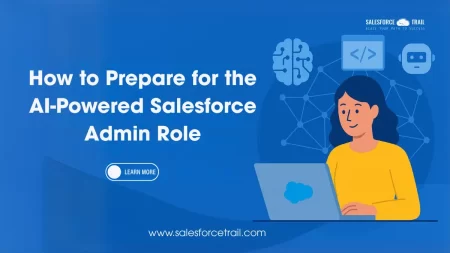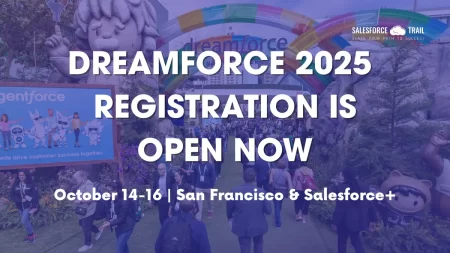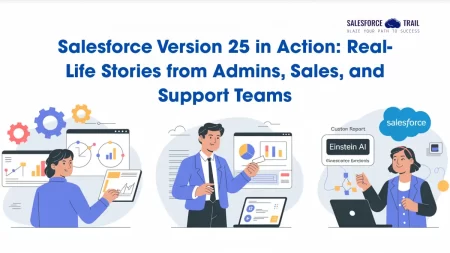Becoming a Salesforce Data Architect is a game-changer for professionals in the Salesforce ecosystem. This certification validates expertise in designing and managing enterprise data solutions, making it a highly sought-after credential. When I decided to pursue this certification, I knew it would be challenging, but with the right strategy and resources, I was able to pass on my first attempt. In this blog, I’ll share my preparation strategy, study materials, and tips to help you achieve the same success.
Understanding the Salesforce Data Architect Exam
Exam Format and Key Details
Before diving into preparation, it’s important to understand the exam format:
- Number of Questions: 60 multiple-choice/multiple-select questions (+5 non-scored questions)
- Time Allotted: 105 minutes
- Passing Score: 58%
- Cost: $400 + applicable taxes
- Retake Fee: $200
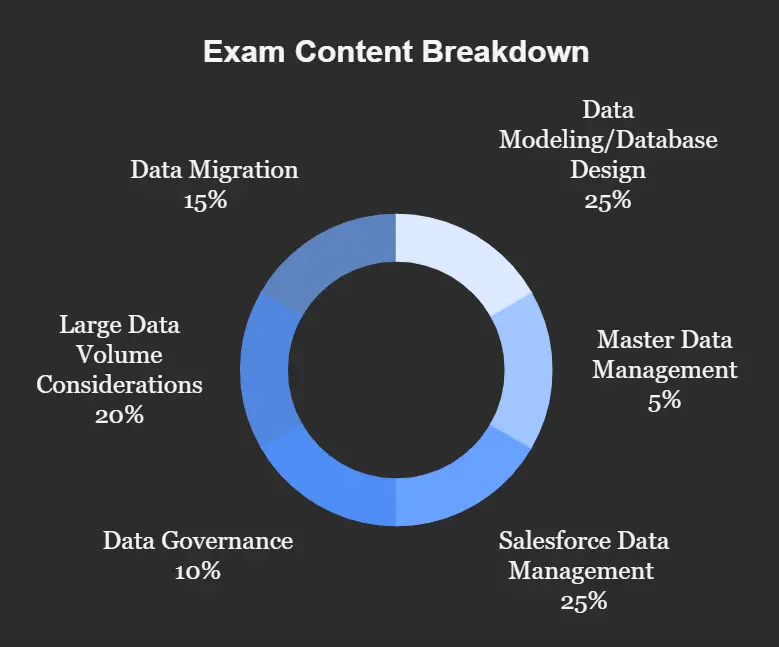
Key Topics Covered
The exam tests your knowledge across six domains:
- Data Modeling/Database Design: 25%
- Master Data Management: 5%
- Salesforce Data Management: 25%
- Data Governance: 10%
- Large Data Volume Considerations: 20%
- Data Migration: 15%
Understanding these areas helps in structuring an effective study plan.
My Study Plan & Preparation Strategy
Defining a Timeline
Since I had prior experience with Salesforce data architecture, I set a 6-week study plan. However, if you’re new to these concepts, you may need 8-10 weeks to prepare thoroughly.
Study Materials I Used
To maximize my learning, I relied on a mix of official resources and external study guides:
Official Salesforce Resources:
- Salesforce Exam Guide – The foundation for my study plan.
- Trailhead Modules & Superbadges – Architect Journey: Data Architecture & Management.
- Salesforce Help Documentation – Topics like Large Data Volume (LDV), Master Data Management, and Data Governance.
Third-Party Resources:
- Salesforce Trail – Their study guide and practice exams were incredibly useful.
- Udemy Courses – Selected courses helped reinforce complex concepts.
- Blogs & YouTube Tutorials – Gained insights from real-world implementations.
Hands-on Practice and Real-world Experience
Theoretical knowledge isn’t enough—hands-on experience is key. I worked on:
- Designing data models in a developer org.
- Practicing data migration scenarios with Data Loader.
- Optimizing Salesforce for large data volumes (LDV).
- Configuring Master Data Management (MDM) strategies.
If you don’t have real-world projects, consider setting up a Salesforce Developer Edition Org to practice.
Exam-Day Strategy & Time Management
On exam day, I followed a structured approach:
- Read questions carefully – Salesforce loves scenario-based questions.
- Used elimination techniques – Narrowed down to the most relevant answers.
- Flagged tough questions – Reviewed them at the end.
- Maintained a steady pace – With 105 minutes for 60 questions, I aimed for 1.5 minutes per question.
Key Challenges & How I Overcame Them
Mastering Large Data Volumes (LDV)
- Challenge: Understanding indexing, skinny tables, and data skew.
- Solution: Practiced by working with real LDV use cases.
Scenario-Based Questions
- Challenge: Many questions had multiple correct-looking answers.
- Solution: Focused on best practices from Salesforce documentation.
Managing Exam Anxiety
- Challenge: First-time nerves can impact performance.
- Solution: Took multiple practice tests to build confidence.
My Results and Next Steps
Passing the Salesforce Data Architect Exam has opened new doors for me in my Salesforce career. Next, I plan to pursue application architecture and work toward becoming a certified technical architect (CTA).
FAQs
- How long should I study for the Data Architect exam?
It depends on your experience, but 6-10 weeks is a good range.
- Is hands-on experience necessary?
Yes! Practical experience with data modeling, migration, and governance is crucial.
- Are practice tests enough to pass?
No. Practice tests help, but real-world understanding is essential.
- What’s the best approach for scenario-based questions?
Focus on Salesforce best practices and performance considerations.
Final Thoughts
The Salesforce Data Architect Certification is challenging but achievable with the right approach. Follow a structured study plan, gain hands-on experience, and practice consistently. If I can do it, so can you!
Are you preparing for this certification? Feel free to share your questions or experiences in the comments!
Must Visit Links:
- AgentExchange is Here Salesforce’s Trusted Marketplace for Agentforce
- Agentblazer vs Trailblazer: What’s the Difference?
- Salesforce AI Specialist Exam Evolves into Certified Agentforce Specialist | What You Need to Know
- How to Prepare for the Certified Agentforce Specialist Certification Exam
Resources
- [Salesforce Developer]- (https://developer.salesforce.com/)
- [Salesforce Success Community] (https://success.salesforce.com/)
For more insights, trends, and news related to Salesforce, stay tuned with Salesforce Trail

Aman Sahu
A Chief Technical Architect at Bugendaitech and a Salesforce Architect with 9+ years of experience driving innovation and delivering scalable CRM solutions. As a leader and visionary, I specialize in bridging the gap between business goals and technology, focusing on Salesforce architecture, AI-powered solutions, and seamless integrations that drive efficiency and growth.
- Aman Sahu#molongui-disabled-link
- Aman Sahu#molongui-disabled-link
- Aman Sahu#molongui-disabled-link
